
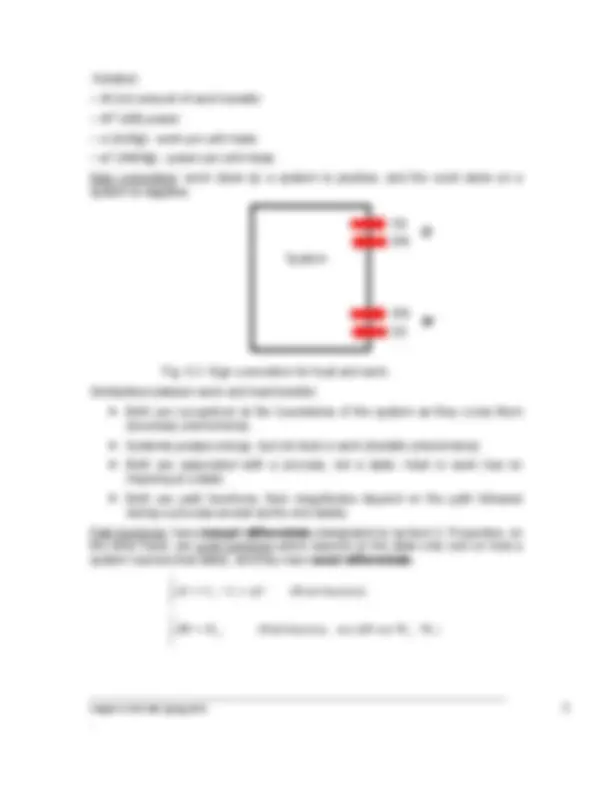
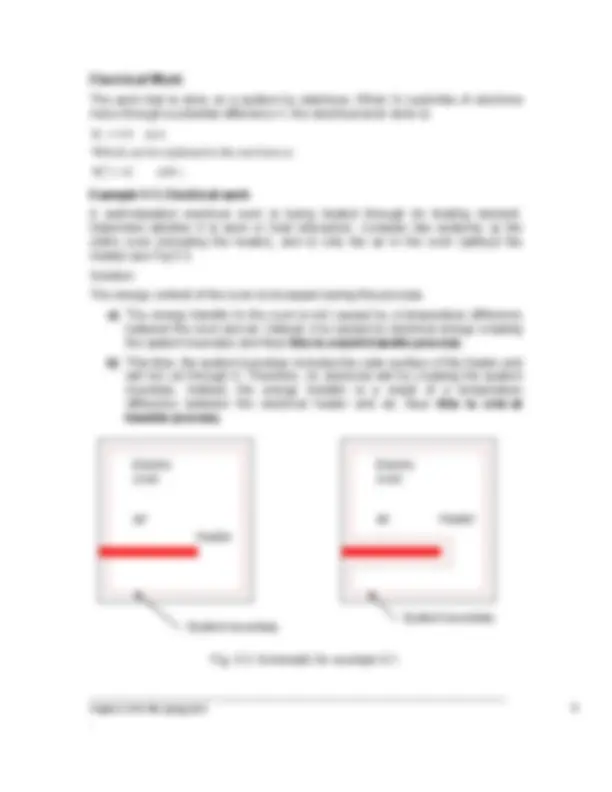
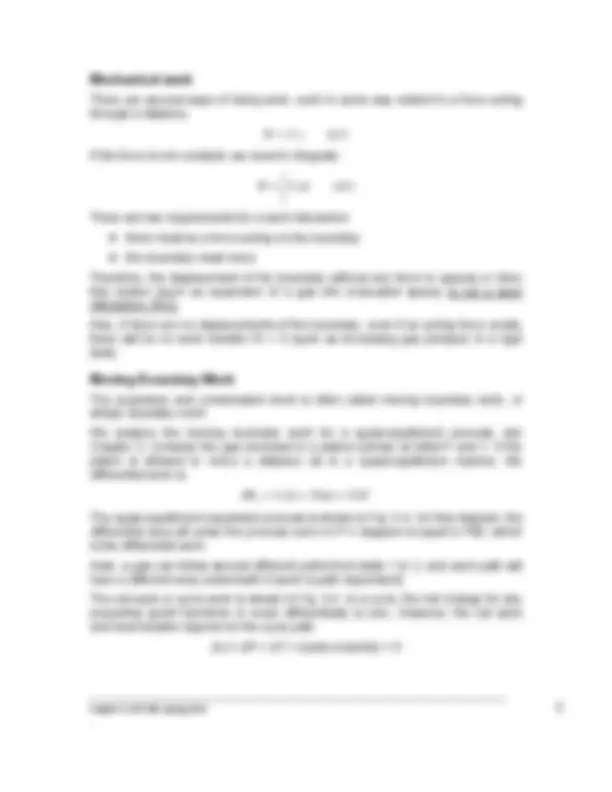
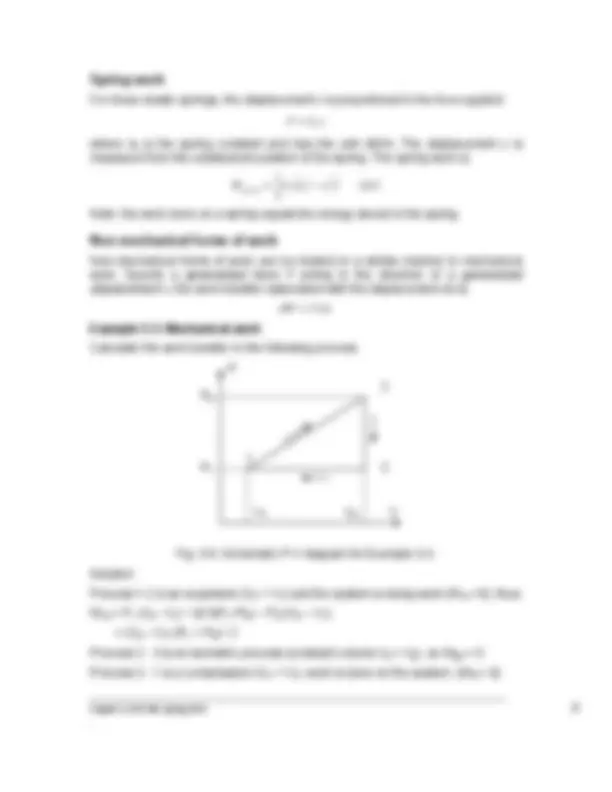
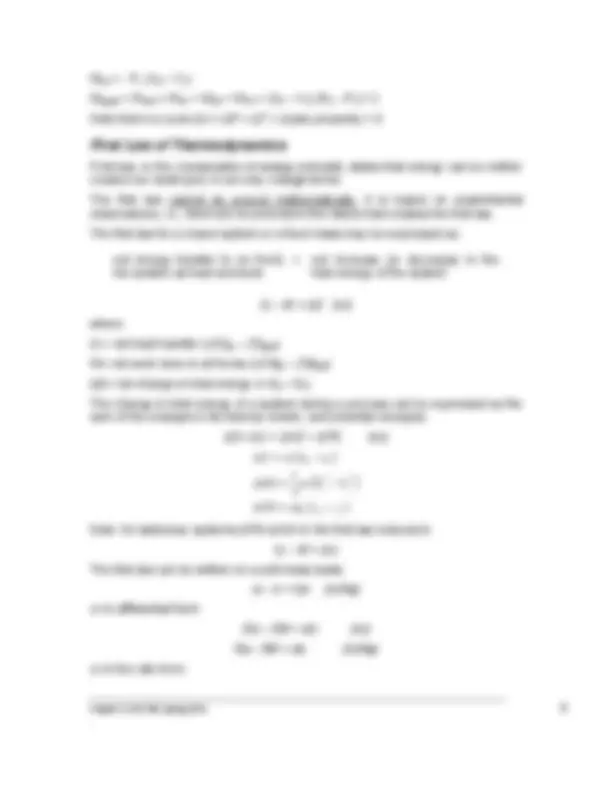
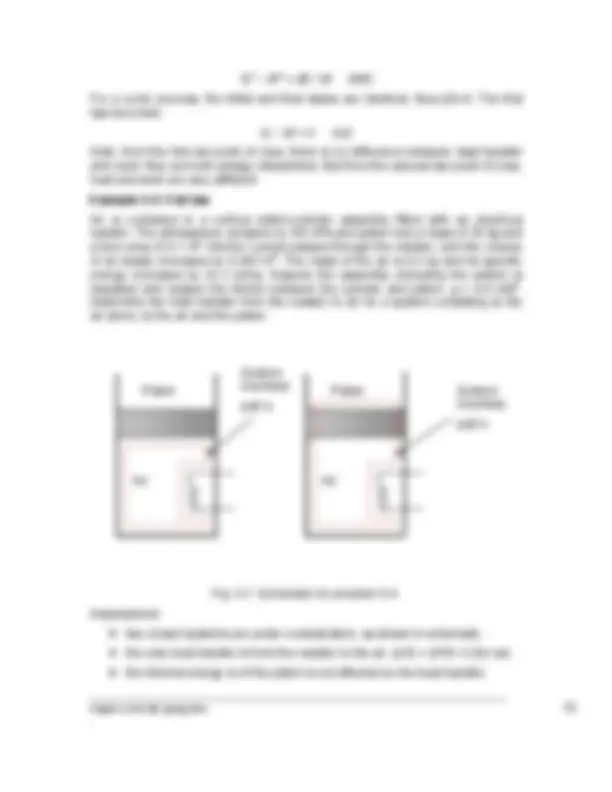
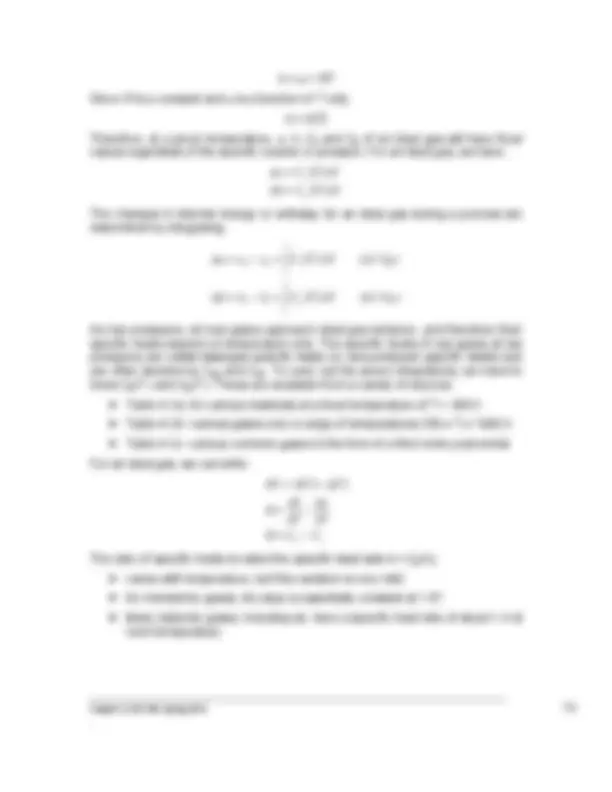
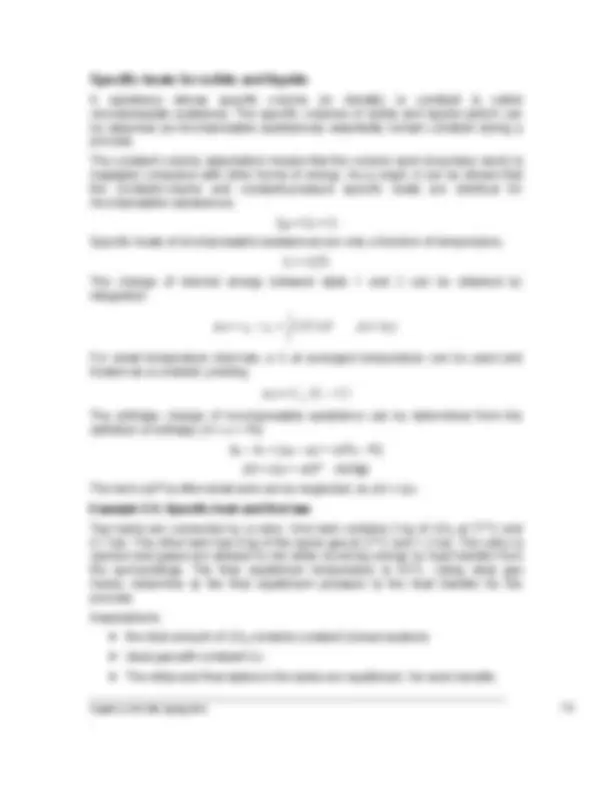
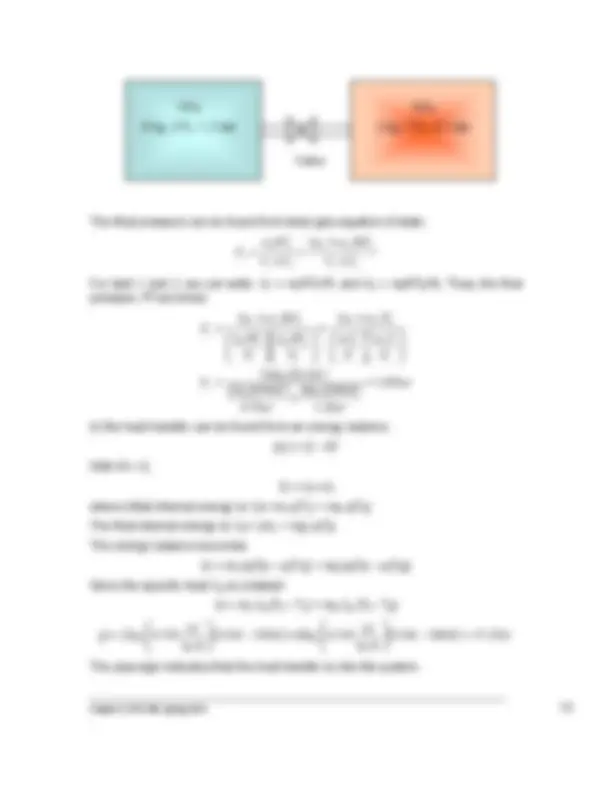
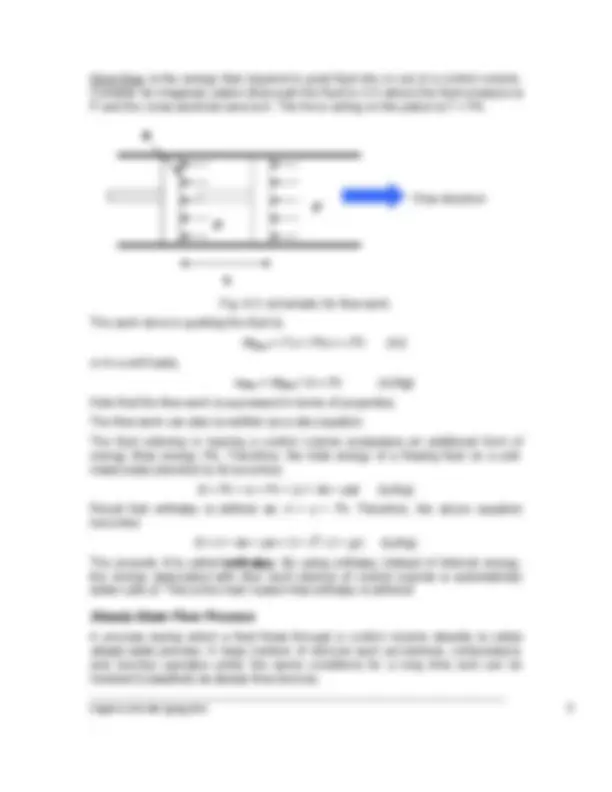
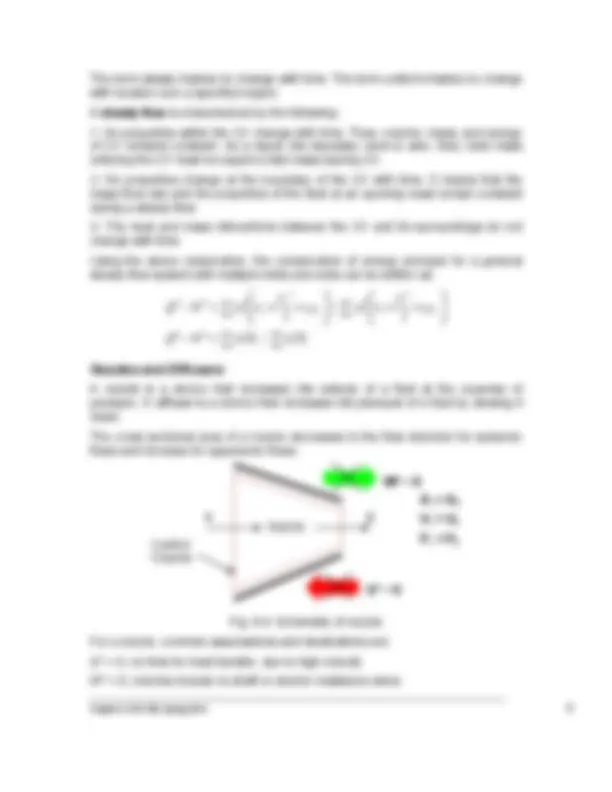
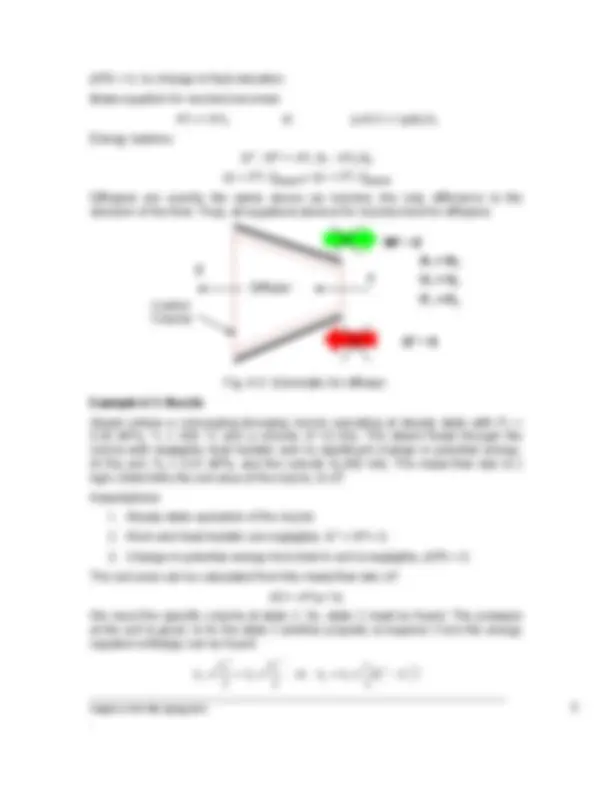
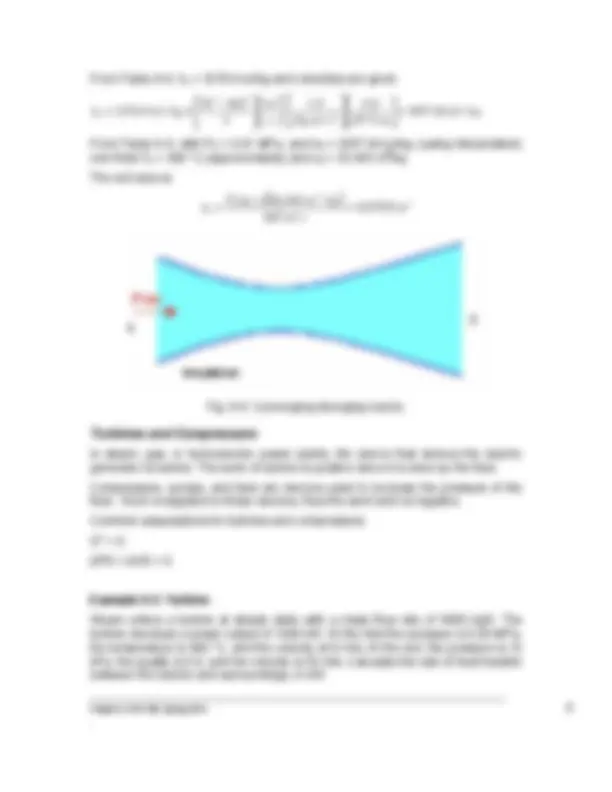
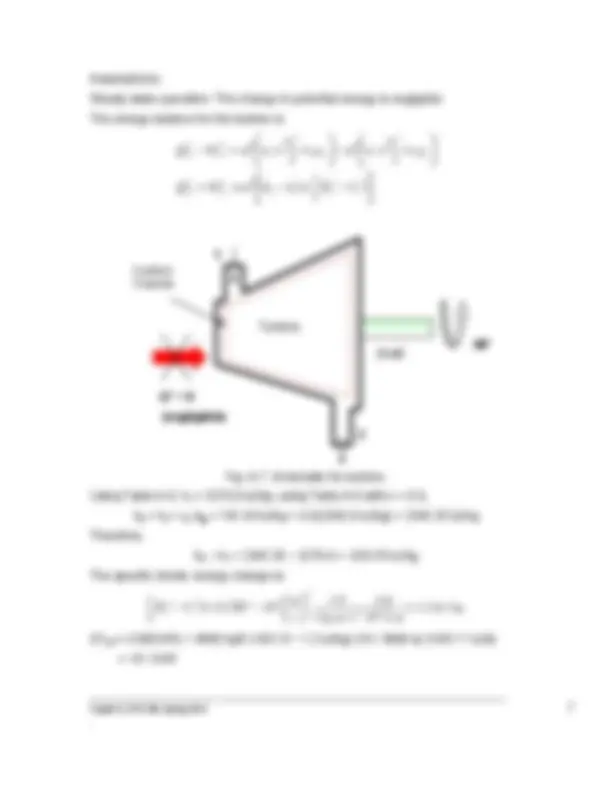
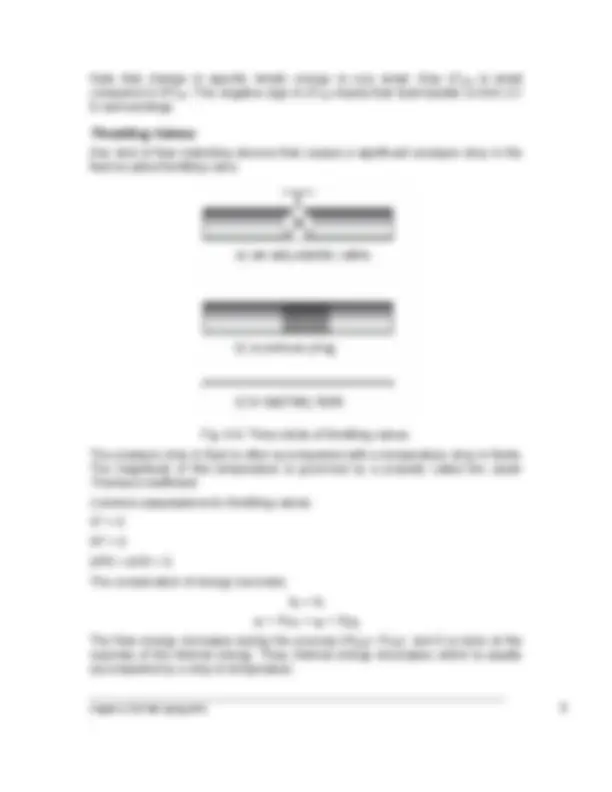
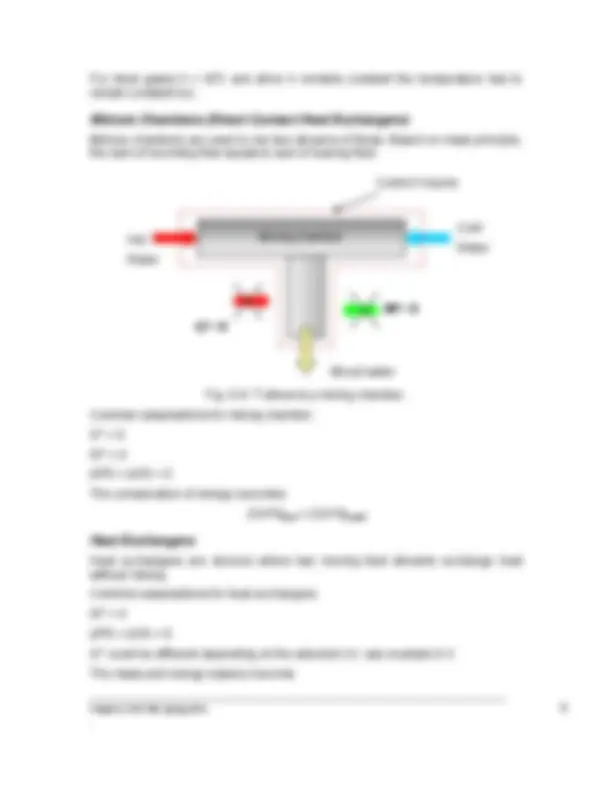

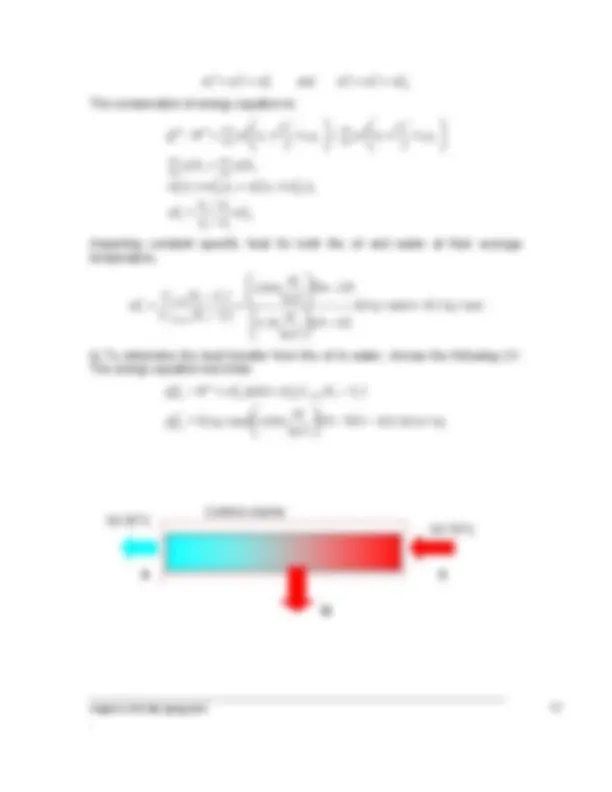


Study with the several resources on Docsity

Earn points by helping other students or get them with a premium plan


Prepare for your exams
Study with the several resources on Docsity

Earn points to download
Earn points by helping other students or get them with a premium plan
Community
Ask the community for help and clear up your study doubts
Discover the best universities in your country according to Docsity users
Free resources
Download our free guides on studying techniques, anxiety management strategies, and thesis advice from Docsity tutors
Various aspects of thermodynamics, including heat and work transfer, specific heats, and the conservation of energy. It discusses the concepts of heat transfer rate (power), work transfer, and power per unit mass. The document also explains the sign conventions for heat and work transfer and introduces the concept of polytropic processes. Additionally, it covers the first law of thermodynamics and its application to various systems.
What you will learn
Typology: Study notes
1 / 26

This page cannot be seen from the preview
Don't miss anything!



















Chapter 5 , ECE 309 , Spring 20 16. 1
The first law of thermodynamics can be simply stated as follows: during an interaction between a system and its surroundings, the amount of energy gained by the system must be exactly equal to the amount of energy lost by the surroundings.
A closed system can exchange energy with its surroundings through heat and work transfer. In other words, work and heat are the forms that energy can be transferred across the system boundary.
Based on kinetic theory, heat is defined as the energy associated with the random motions of atoms and molecules.
Heat is defined as the form of energy that is transferred between two systems by virtue of a temperature difference.
Note: there cannot be any heat transfer between two systems that are at the same temperature.
Note: It is the thermal (internal) energy that can be stored in a system. Heat is a form of energy in transition and as a result can only be identified at the system boundary.
Heat has energy units kJ (or BTU). Rate of heat transfer is the amount of heat transferred per unit time.
Heat is a directional (or vector) quantity; thus, it has magnitude, direction and point of action.
Notation:
Sign convention: Heat Transfer to a system is positive , and heat transfer from a system is negative. It means any heat transfer that increases the energy of a system is positive, and heat transfer that decreases the energy of a system is negative.
Chapter 5 , ECE 309 , Spring 20 16. 2
Fig. 5 -1: Sign convention: positive if to the system, negative if from the system.
Heat can be transferred in three different modes conduction, convection , and radiation. All modes of heat transfer require the existence of a temperature difference.
Conduction: is the transfer of energy from the more energetic particles to the adjacent less energetic particles as a result of interactions between particles.
In solids, conduction is due to the combination of vibrations of the molecules in a lattice and the energy transport by free electrons. Conduction will be discussed in more details in Ch 10 & 11.
Convection: is the mode of energy transfer between a solid surface and the adjacent liquid or gas which is in motion, and it involves the combined effects of conduction and fluid motion ( advection ).
Convection is called forced if the fluid is forced to flow by external means such as a fan or a pump. It is called free or natural if the fluid motion is caused by buoyancy forces that are induced by density differences due to the temperature variation in a fluid. Convection will be discussed in more details in Ch 12, 13 & 1 4.
Radiation: is the energy emitted by matter in the form of electromagnetic waves (or photons) as a result of the changes in the electronic configurations of the atoms or molecules. Radiation will be discussed in more details in Ch 1 5.
Work is the energy interaction between a system and its surroundings. More specifically, work is the energy transfer associated with force acting through a distance.
Q = 5 kJ
Q = - 5 kJ
Heat in
System Heat out
Chapter 5 , ECE 309 , Spring 20 16. 4
The work that is done on a system by electrons. When N coulombs of electrons move through a potential difference V, the electrical work done is:
Whichcanbeexplainedin therateformas
e VI kW
W (^) e VN kJ
Example 5-1: Electrical work
A well-insulated electrical oven is being heated through its heating element. Determine whether it is work or heat interaction. Consider two systems: a) the entire oven (including the heater), and b) only the air in the oven (without the heater) see Fig 5 -3.
Solution:
The energy content of the oven is increased during this process.
a) The energy transfer to the oven is not caused by a temperature difference between the oven and air. Instead, it is caused by electrical energy crossing the system boundary and thus: this is a work transfer process. b) This time, the system boundary includes the outer surface of the heater and will not cut through it. Therefore, no electrons will be crossing the system boundary. Instead, the energy transfer is a result of a temperature difference between the electrical heater and air, thus: this is a he at transfer process.
Fig. 5 -3: Schematic for example 5 -1.
Electric oven
air Heater
Heater
Electric oven
air
System boundary
System boundary
Chapter 5 , ECE 309 , Spring 20 16. 5
There are several ways of doing work, each in some way related to a force acting through a distance.
W = F. s ( kJ )
If the force is not constant, we need to integrate:
= ∫
2
1
W F. ds ( kJ )
There are two requirements for a work interaction:
¾ there must be a force acting on the boundary ¾ the boundary must move
Therefore, the displacement of the boundary without any force to oppose or drive this motion (such as expansion of a gas into evacuated space) is not a work interaction, W=0.
Also, if there are no displacements of the boundary, even if an acting force exists, there will be no work transfer W = 0 (such as increasing gas pressure in a rigid tank).
The expansion and compression work is often called moving boundary work, or simply boundary work.
We analyze the moving boundary work for a quasi-equilibrium process, see Chapter 3. Consider the gas enclosed in a piston-cylinder at initial P and V. If the piston is allowed to move a distance ds in a quasi-equilibrium manner, the differential work is:
The quasi-equilibrium expansion process is shown in Fig. 5 -4. On this diagram, the differential area dA under the process curve in P-V diagram is equal to PdV , which is the differential work.
Note: a gas can follow several different paths from state 1 to 2, and each path will have a different area underneath it (work is path dependent).
The net work or cycle work is shown in Fig. 5 -5. In a cycle, the net change for any properties (point functions or exact differentials) is zero. However, the net work and heat transfer depend on the cycle path.
∆U = ∆P = ∆T = ∆(any property) = 0
Chapter 5 , ECE 309 , Spring 20 16. 7
(^2 1) n kJ n
mRT T W (^) polytropic ≠ −
The special case n =1 is the isothermal expansion P 1 V 1 = P 2 V 2 = mRT 0 = C, which can be found from:
ln , 1 ( ) 1
2 1 1
2
1
2
1
, n kJ V
dV PV V
W (^) b isothermal PdV ⎟⎟ = ⎠
Since for an ideal gas, PV=mRT 0 at constant temperature T 0 , or P=C/V.
Example 5-2: Polytropic work
A gas in piston-cylinder assembly undergoes a polytropic expansion. The initial pressure is 3 bar, the initial volume is 0.1 m^3 , and the final volume is 0.2 m^3. Determine the work for the process, in kJ , if a) n=1.5, b) n=1.0, and c) n=0.
Solution:
Assume that i) the gas is a closed system, ii) the moving boundary is only work mode, and iii) the expansion is polytropic.
a) n =1.
2
1
2 2 1 1 1
V
V n
W PdV
We need P 2 that can be found from P 1 V 1 n^ = P 2 V 2 n :
n
2
1 2 1 ⎟ = ⎠
kJ Nm
kJ bar
bar m N m W 17. 6
3
3 5 2 ⎟^ = ⎠
b) n =1, the pressure volume relationship is PV = constant. The work is:
Nm
kJ bar
N m W bar m
W PdV PV
ln
ln
3
5 2 3
1
2 11
2
1
⎟^ = ⎠
c) For n = 0, the pressure-volume relation reduces to P=constant ( isobaric process ) and the integral become W= P (V 2 -V 1 ).
Substituting values and converting units as above, W=30 kJ.
Chapter 5 , ECE 309 , Spring 20 16. 8
For linear elastic springs, the displacement x is proportional to the force applied:
F = ks x
where ks is the spring constant and has the unit kN/m. The displacement x is measured from the undisturbed position of the spring. The spring work is:
1
2 W (^) spring = ksx 2 − x kJ
Note: the work done on a spring equals the energy stored in the spring.
Non-mechanical forms of work can be treated in a similar manner to mechanical work. Specify a generalized force F acting in the direction of a generalized displacement x , the work transfer associated with the displacement dx is:
Example 5-3: Mechanical work
Calculate the work transfer in the following process:
Fig. 5 -6: Schematic P-V diagram for Example 3-3.
Solution:
Process 1-2 is an expansion (V 2 > V 1 ) and the system is doing work (W 12 >0), thus:
W 12 = P 1 (V 2 - V 1 ) + [0.5(P 1 +P 2 ) – P 1 ] (V 2 – V 1 )
= (V 2 – V 1 ) (P 1 + P 2 ) / 2
Process 2 - 3 is an isometric process (constant volume V 3 = V 2 ), so W 23 = 0
Process 3 - 1 is a compression (V 3 > V 1 ), work is done on the system, (W 31 < 0)
Chapter 5 , ECE 309 , Spring 20 16. 10
Q° – W° = dE / dt (kW)
For a cyclic process, the initial and final states are identical, thus ∆E=0. The first law becomes:
Q – W = 0 (kJ)
Note: from the first law point of view, there is no difference between heat transfer and work , they are both energy interactions. But from the second law point of view, heat and work are very different.
Example 5-4: Fist law
Air is contained in a vertical piston-cylinder assembly fitted with an electrical resistor. The atmospheric pressure is 100 kPa and piston has a mass of 50 kg and a face area of 0.1 m^2. Electric current passes through the resistor, and the volume of air slowly increases by 0.045 m^3. The mass of the air is 0.3 kg and its specific energy increases by 42.2 kJ/kg. Assume the assembly (including the piston) is insulated and neglect the friction between the cylinder and piston, g = 9.8 m/s^2. Determine the heat transfer from the resistor to air for a system consisting a) the air alone, b) the air and the piston.
Fig. 5 -7: Schematic for problem 5 -4.
Assumptions:
¾ two closed systems are under consideration, as shown in schematic. ¾ the only heat transfer is from the resistor to the air. ∆KE = ∆PE= 0 (for air) ¾ the internal energy is of the piston is not affected by the heat transfer.
Air
Piston
Air
Piston System boundary part b
System boundary part a
Chapter 5 , ECE 309 , Spring 20 16. 11
a) taking the air as the system,
(∆KE + ∆PE + ∆U)air = Q – W Q = W + ∆Uair
For this system work is done at the bottom of the piston. The work done by the system is (at constant pressure):
2
1
2 1
V
V
W PdV PV V
The pressure acting on the air can be found from:
PApiston = mpiston g + Patm Apiston
kPa kPa Pa
kPa N m
Pa m
kg m s P
m g P (^) atm
2 2
2
piston
piston
Thus, the work is
W = (104.91 kPa)(0.045m^3 ) = 4.721 kJ
With ∆Uair = mair ∆uair, the heat transfer is
Q = W + mair ∆uair = 4.721 kJ + (0.3 kg)(42.2 kJ/kg) = 17.38 kJ
b) system consisting the air and the piston. The first law becomes:
(∆KE + ∆PE + ∆U)air + (∆KE + ∆PE + ∆U)piston = Q – W
where (∆KE = ∆PE)air = 0 and (∆KE = ∆U)piston= 0. Thus, it simplifies to:
(∆U)air + (∆PE)piston = Q – W
For this system, work is done at the top of the piston and pressure is the atmospheric pressure. The work becomes
W = Patm ∆V = (100 kPa)(0.045m^3 ) = 4.5 kJ
The elevation change required to evaluate the potential energy change of the piston can be found from the volume change:
∆z = ∆V / Apiston = 0.045 m^3 / 0.1 m^2 = 0.45 m (∆PE)piston = m (^) piston g ∆z = (50 kg)(9.81 m/s^2 )(0.45 m) = 220.73 J = 0.221 kJ Q = W + (∆PE)piston + mair ∆uair Q = 4.5 kJ + 0.221 kJ + (0.3 kg)(42.2 kJ/kg) = 17.38 kJ
Note that the heat transfer is identical in both systems.
Chapter 5 , ECE 309 , Spring 20 16. 13
h = u + RT
Since R is a constant and u is a function of T only:
h = h(T)
Therefore, at a given temperature, u, h, C v and C p of an ideal gas will have fixed values regardless of the specific volume or pressure. For an ideal gas, we have:
( ) dh C ( T ) dT
du C T dT p
The changes in internal energy or enthalpy for an ideal gas during a process are determined by integrating:
( )
( ) ( / )
2
1
2 1
2
1
2 1
h h h C T dT kJ kg
u u u C T dT kJ kg
p
v
∫
∫
As low pressures, all real gases approach ideal-gas behavior, and therefore their specific heats depend on temperature only. The specific heats of real gases at low pressures are called ideal-gas specific heats ( or zero-pressure specific heats) and are often denoted by Cp0 and Cv0. To carry out the above integrations, we need to know Cv(T ) and Cp(T ). These are available from a variety of sources:
¾ Table A-2a: for various materials at a fixed temperature of T = 300 K ¾ Table A-2b: various gases over a range of temperatures 250 ≤ T ≤ 1000 K ¾ Table A-2c: various common gases in the form of a third order polynomial
For an ideal gas, we can write:
( ) ( )
R Cp C v
dT
du dT
dh R
RT hT uT
The ratio of specific heats is called the specific heat ratio k = Cp/Cv :
¾ varies with temperature, but this variation is very mild. ¾ for monatomic gases, its value is essentially constant at 1.67. ¾ Many diatomic gases, including air, have a specific heat ratio of about 1.4 at room temperature.
Chapter 5 , ECE 309 , Spring 20 16. 14
A substance whose specific volume (or density) is constant is called incompressible substance. The specific volumes of solids and liquids (which can be assumed as incompressible substances) essentially remain constant during a process.
The constant volume assumption means that the volume work (boundary work) is negligible compared with other forms of energy. As a result, it can be shown that the constant-volume and constant-pressure specific heats are identical for incompressible substances:
Cp = Cv = C
Specific heats of incompressible substances are only a function of temperature,
C = C(T)
The change of internal energy between state 1 and 2 can be obtained by integration:
( ) ( / )
2
1
∆ u = u 2 − u 1 =∫ CT dT kJ kg
For small temperature intervals, a C at averaged temperature can be used and treated as a constant, yielding:
∆ u ≈ Cave ( T 2 − T 1 )
The enthalpy change of incompressible substance can be determined from the definition of enthalpy (h = u + Pv)
h 2 – h 1 = (u 2 – u 1 ) + v(P 2 – P 1 ) ∆h = ∆u + v∆P (kJ/kg)
The term v∆P is often small and can be neglected, so ∆h = ∆u.
Example 5-5: Specific heat and first law
Two tanks are connected by a valve. One tank contains 2 kg of CO 2 at 77°C and 0.7 bar. The other tank has 8 kg of the same gas at 27°C and 1.2 bar. The valve is opened and gases are allowed to mix while receiving energy by heat transfer from the surroundings. The final equilibrium temperature is 42°C. Using ideal gas model, determine a) the final equilibrium pressure b) the heat transfer for the process.
Assumptions:
¾ the total amount of CO 2 remains constant (closed system). ¾ ideal gas with constant Cv. ¾ The initial and final states in the tanks are equilibrium. No work transfer.
Chapter 6 , ECE 309 , Spring 20 16. 1
The first law is discussed for closed systems in Chapter 5. In this Chapter, we extend the conservation of energy to systems that involve mass flow across their boundaries, control volumes.
Any arbitrary region in space can be selected as control volume. There are no concrete rules for the selection of control volumes. The boundary of control volume is called a control surface.
Like energy, mass is a conserved property, and it cannot be created or destroyed. Mass and energy can be converted to each other according to Einstein’s formula: E = mc^2 , where c is the speed of light. However, except for nuclear reactions, the conservation of mass principle holds for all processes.
For a control volume undergoing a process, the conservation of mass can be stated as:
total mass entering CV
= net change in mass within CV
∑ mi^ −^ ∑ me =∆ m CV
Fig. 6 -1: Conservation of mass principle for a CV.
The conservation of mass can also be expressed in the rate form:
∑ m^ • i^ −^ ∑ m • e = dmCV /^ dt
The amount of mass flowing through a cross section per unit time is called the mass flow rate and is denoted by m°. The mass flow rate through a differential area dA is:
dm°= ρVn dA
m°i
m°o
Control volume
Chapter 6 , ECE 309 , Spring 20 16. 2
where V is the velocity component normal to dA. Thus, the mass flow rate for the entire cross-section is obtained by:
m VdA (kg/s ) A
=∫ n
Assuming one-dimensional flow, a uniform (averaged or bulk) velocity can be defined:
m°= ρ V A (kg/s)
where V (m/s) is the fluid velocity normal to the cross sectional area. The volume of the fluid flowing through a cross-section per unit time is called the volumetric flow, V°:
V VdA VA (m 3 /s) A
= (^) ∫ n =
The mass and volume flow rate are related by: m°=ρV°= V°/ v.
For control volumes, an additional mechanism can change the energy of a system: mass flow in and out of the control volume. Therefore, the conservation of energy for a control volume undergoing a process can be expressed as
total energy crossing boundary as heat and work
= net change in energy of CV
Q − W +∑ Ein , mass +∑ Eout , mass =∆ E CV
This equation is applicable to any control volume undergoing any process. This equation can also be expressed in rate form:
Q • − W • +∑ dEin , mass / dt +∑ dEout , mass / dt = dECV / dt
Fig. 6 -2: Energy content of CV can be changed by mass flow in/out and heat and work interactions.
Mass in
Mass out
Control W volume
Chapter 6 , ECE 309 , Spring 20 16. 4
The term steady implies no change with time. The term uniform implies no change with location over a specified region.
A steady flow is characterized by the following:
1- No properties within the CV change with time. Thus, volume, mass, and energy of CV remains constant_. As a result, the boundary work is zero_. Also, total mass entering the CV must be equal to total mass leaving CV.
2- No properties change at the boundary of the CV with time. It means that the mass flow rate and the properties of the fluid at an opening must remain constant during a steady flow.
3- The heat and mass interactions between the CV and its surroundings do not change with time.
Using the above observation, the conservation of energy principle for a general steady-flow system with multiple inlets and exits can be written as:
e e i i
i
i e i i
e e e
Q W m m
gz
gz m h
Q W m h
∑ θ^ ∑^ θ
∑ ∑
2 2
A nozzle is a device that increases the velocity of a fluid at the expense of pressure. A diffuser is a device that increases the pressure of a fluid by slowing it down.
The cross sectional area of a nozzle decreases in the flow direction for subsonic flows and increase for supersonic flows.
Fig. 6 -4: Schematic of nozzle
For a nozzle, common assumptions and idealizations are:
Q° = 0, no time for heat transfer, due to high velocity
W° = 0, nozzles include no shaft or electric resistance wires
Nozzle
Control P^1 < P^2 Volume
Chapter 6 , ECE 309 , Spring 20 16. 5
∆PE = 0, no change in fluid elevation.
Mass equation for nozzles becomes:
m° 1 = m° 2 or ρ 1 A 1 V 1 = ρ 2 A 2 V 2
Energy balance:
Q° - W° = m° 1 θ 1 - m° 2 θ 2 (h + V^2 / 2)at inlet = (h + V^2 / 2)at exit
Diffusers are exactly the same device as nozzles; the only difference is the direction of the flow. Thus, all equations derived for nozzles hold for diffusers.
Fig. 6 -5: Schematic for diffuser.
Example 6-1: Nozzle
Steam enters a converging-diverging nozzle operating at steady state with P 1 = 0.05 MPa, T 1 = 400 °C and a velocity of 10 m/s. The steam flows through the nozzle with negligible heat transfer and no significant change in potential energy. At the exit, P 2 = 0.01 MPa, and the velocity is 665 m/s. The mass flow rate is 2 kg/s. Determine the exit area of the nozzle, in m^2.
Assumptions:
The exit area can be calculated from the mass flow rate m° :
A2 = m°v 2 / V 2
We need the specific volume at state 2. So, state 2 must be found. The pressure at the exit is given; to fix the state 2 another property is required. From the energy equation enthalpy can be found:
2 1 1
2 2 (^2 )
h h V V
h
h + = + ⇒ = + −
Diffuser
Control P^1 < P^2 Volume
Q° = 0